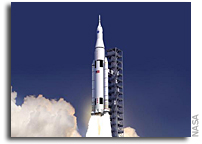NASA Selects Space Launch System Advanced Development Proposals

NASA has selected 26 proposals from academia and industry for advanced development activities for the nation’s next heavy lift rocket, the Space Launch System (SLS). Proposals selected under this NASA Research Announcement (NRA) seek innovative and affordable solutions to evolve the launch vehicle from its initial configuration to its full lift capacity capable of sending humans farther into deep space than ever before.
NASA sought proposals in a variety of areas, including concept development, trades and analyses, propulsion, structures, materials, manufacturing, avionics and software.
“Engaging with academia and industry gives us the opportunity to take advantage of the ingenuity and expertise beyond NASA,” said William Gerstenmaier, associate administrator for the Human Exploration and Operations Mission Directorate at NASA Headquarters in Washington. “It will help us optimize affordability while integrating mature technical upgrades into future vehicles.”
NASA is partnering with the U.S. Air Force on this research announcement in support of common national rocket propulsion goals.
Individual awards will vary with a total government investment of as much as $48 million. Initial fiscal year 2012 awards are worth as much as $8 million for industry and $2.5 million for academia. The selections will be made in advance of negotiations for potential awards. Awards depend on successful negotiation and stability of appropriated funds.
The proposals from academia selected for contract and grant negotiations are:
— “High Electric Density Device for Aerospace Applications,” Auburn University, Ala.
— “Challenges Towards Improved Friction Stir Welds Using On-line Sensing of Weld Quality,” Louisiana State University, Baton Rouge, La.
— “A New Modeling Approach for Rotating Cavitation Instabilities in Rocket Engine Turbopumps,” Massachusetts Institute of Technology, Cambridge, Mass.
— “Algorithmic Enhancements for High-Resolution Hybrid RANS-LES Using Loci-CHEM,” Mississippi State University, Miss.
— “Next Generation Simulation Infrastructure on Large Scale Multicore Architecture,” Mississippi State University, Miss.
— “Characterization of Aluminum/Alumina/Carbon Interactions under Simulated Rocket Motor Conditions,” Pennsylvania State University, University Park, Pa.
— “Development of Subcritical Atomization Models in the Loci Framework for Liquid Rocket Injectors,” University of Florida, Gainesville, Fla.
— “Determination of Heat Transfer Coefficients for Two-Phase Flows of Cryogenic Propellants During Line Chilldown and Fluid Transport,” University of Florida, Gainesville, Fla.
— “Validation of Subsonic Film Cooling Numerical Simulations Using Detailed Measurements and Novel Diagnostics,” University of Maryland, College Park, Md.
— “Validation of Supersonic Film Cooling Numerical Simulations Using Detailed Measurements and Novel Diagnostics,” University of Maryland, College Park, Md.
— “Advanced LES and Laser Diagnostics to Model Transient Combustion-Dynamical Processes in Rocket Engines: Prediction of Flame Stabilization and Combustion-Instabilities,” University of Michigan, Ann Arbor, Mich.
— “Acoustic Emission-Based Health Monitoring of Space Launch System Structures,” University of Utah, Salt Lake City
Industry proposals selected for contract negotiations are:
— “Development of a Fluid-Structure Interaction Methodology for Predicting Engine Loads,” ATA Engineering, Inc., San Diego
— “Space Launch System (SLS) Advanced Development Affordable Composite Structures,” ATK Space Systems, Inc., Clearfield, Utah
— “Ball Reliable Advanced Integrated Network,” Ball Aerospace & Technologies Corp., Huntsville, Ala.
— “Affordable Structural Weight Reduction for SLS Block 1A,” Collier Research and Development Corp., Newport News, Va.
— “DESLA Systems Engineering and Risk Reduction for AUSEP,” Exquadrum, Inc., Adelanto, Calif.
— “Space Launch System Program AUSEP LOX Flow Control Valve,” MOOG, Inc. Space and Defense Group, Aurora, N.Y.
— “Affordable Upper Stage Engine Advanced Development,” Northrop Grumman Systems Corp., Redondo Beach, Calif.
— “Hybrid Precision Casting for Regeneratively-Cooled Thrust Chamber Components,” Orbital Technologies Corp., Madison, Wis.
— “NASA Space Launch System (SLS) Advanced Development, Affordable Upper Stage Engine Program (AUSE) Study,” Pratt & Whitney Rocketdyne, Inc., Jupiter, Fla.
— “Advanced Ordnance Systems Demonstration,” Reynolds Systems, Inc., Middletown, Calif.
— “Cryo-Tracker Mass Gauging System,” Sierra Lobo, Inc., Freemont, Ohio
— “Efficient High-Fidelity Design and Analysis Tool for Unsteady Flow Physics in Space Propulsion Geometries,” Streamline Numerics, Inc. Gainesville, Fla.
— “Robust Distributed Sensor Interface Modules (DSIM) for SLS,” The Boeing Company, Huntington Beach, Calif.
— “Integrated Vehicle Fluids (IVF),” United Launch Alliance, Centennial, Colo.
Designed to be flexible for launching payloads and spacecraft, including NASA’s Orion Multi-Purpose Crew Vehicle that will take humans beyond low Earth orbit, SLS will enable the agency to achieve its deep space exploration goals.
“While we are moving out on the initial 70-metric-ton configuration of the vehicle, we will continue to examine concepts, designs and options that will advance the rocket to a 130-metric-ton vehicle, which is essential for deep space exploration,” said Todd May, SLS program manager at NASA’s Marshall Space Flight Center in Huntsville, Ala. “Competitive opportunities like this research announcement ensure we deliver a safe, affordable, sustainable launch system.”
The proposal selections are the first step in the NRA procurement process. The period of performance for these awards will be one year with as many as two one-year options. The second step, formal contract awards, will follow further negotiations between NASA and selected organizations.
All proposals will be valid for 12 months to allow for a later award if the opportunity becomes available, unless the offeror withdraws the proposal prior to award. Successful offerors to this NRA will not be guaranteed an award for any future advanced development acquisition.
The first flight test of NASA’s SLS, which will feature a configuration for a 77 ton (70-metric-ton) lift capacity, is scheduled for 2017 from NASA’s Kennedy Space Center in Florida.
For information about NASA’s Space Launch System, visit: http://www.nasa.gov/sls








